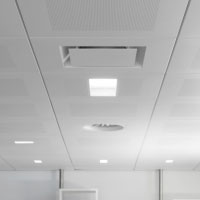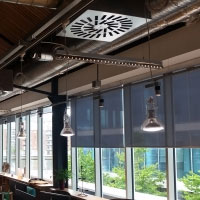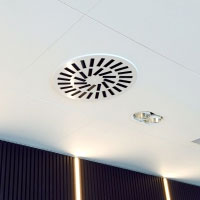Blog
Download our brochure

Stay informed
i
Grilles and diffusers are installed at the terminal point of ducting systems and they introduce or extract air to or from the conditioned space in order to achieve the desired indoor conditions. There is a plethora of different types and designs of grilles and diffusers each with unique characteristics and each suitable for specific applications. This article aims in presenting the main types of grilles and diffusers as well as providing an insight into the selection process of the proper type and size of air outlets.
Grilles
In most cases, grilles contain vertical and/or horizontal vanes which are mounted on a rigid frame. Various grille types are frequently used in any type of application both for residential and commercial buildings, for example wall, ceiling, exposed duct or floor installations.
Grilles with adjustable blades allow the user to manually set the angle of its vertical and/or horizontal vanes. Adjustable grilles are often categorized as single deflection, which allow the regulation of air flow in the vertical or horizontal direction, or as double deflection which contain both vertical and horizontal movable vanes. Alternatively, grilles with fixed blades have non movable vanes that can be either straight or at an angle. Grilles that have non movable bars only along the long dimension of the grille are called Linear bar grilles. Grilles with non movable blades are mostly used as air return grilles.
Adjustable grilles are often the preferred solution for high wall air outlets. For ceiling installations, grilles with curved blades, that project the airstream parallel to the ceiling, are usually preferred for ceiling heights lower than 3m. For spaces with higher ceilings, vertical air discharge is more likely to be the preferred choice. In floor applications, linear bar grilles are considered a popular choice and are used to project the conditioned air along walls. When determining the correct floor grilles it is of great importance to take into consideration the magnitude and the frequency of the loading that the grilles are expected to encounter. Preferably, floor grilles should be places in locations that are not frequently stepped by passing users of the building.
Diffusers
Diffusers are in most cases the preferred choice for ceiling applications. Depending on the configuration of its deflectors, diffusers can produce radial, directional horizontal or even perpendicular air patterns. There are numerous typed of diffusers available in the market.
Round and square diffusers consist of concentric rings or squares respectively and are a very popular choice for gypsum ceiling or exposed duct installation. Perforated diffusers, as their name suggests, are made of a perforated plate and have a free area at the face of the diffuser of approximately 50%.
Linear slot diffusers can consist of single or multiple (normally up to 6) slots. Multiple slot diffusers can be combined to form diffusers with long continuous lengths or even corner pieces. They can offer great versatility when it comes to air discharge patterns as they can produce vertical, one or two way horizontal or alternating horizontal air patterns to meet a wide range of requirements.
Displacement diffusers are used to introduce air into a space without mixing the supply air with the ambient room air. This is achieved by the, relatively large dimensions of these diffusers which allow them to introduce supply air at a low velocity. As a result, the cold, low velocity air drops to the floor of the conditioned space, due to its greater density, thus achieving the desired indoor condition in the occupied zone. Displacement diffusers are mostly used in floor or wall installations.
Jet diffusers are almost exclusively used in commercial applications with large open spaces, as they have the ability to produce high throw air streams without increasing significantly the noise levels. They can be manually or electronically adjusted over 360°. Jet diffusers are available in short and long pipe models.
Selection process of grille or diffuser
Determining which is the proper type and size of a grille to be installed for a specific application depends on numerous factors. Firstly, the type of air outlet mainly depends on the desired air flow discharge pattern. Factors like the use and geometry of the room, the specific places inside the room where occupants are expected to be passing by or sitting, play a dominant role in choosing whether the air outlets should produce horizontal, or vertical discharge, or whether it should have adjustable or fixed blades. Equally important role in the decision making process play the aesthetics criteria of the specific space set by the architect or the interior designer. Grilles and diffusers are most frequently made of aluminium or steel, and can be painted in any standard RAL color.
The size of an air grille or diffuser is mainly a factor of the magnitude of the air flow passing through it. Installers and designers of air systems must always consult the technical data sheet of an air outlet given by the manufacturer, before selecting and installing a product in order to know exactly what is the appropriate range of air flows that a given grille or diffuser size can handle. Undersized air outlets often result in noisy air discharge resulting from the high outlet air velocity whereas oversized air outlets can result in reduced throw which does not allow the conditioned air to reach the desired areas of the conditioned space.
Conclusion
Air outlets, like grilles and diffusers, play a very important role in the smooth and efficient operation of an air distribution system. Selecting the right product for can be a complex process, as the selected products many times have to meet both specific aerodynamic and aesthetic criteria. For this reason, the market offers a wide variety of products that are able to satisfy most of the needs of today’s HVAC system designs.




